Introduction: Florence in the Seicento
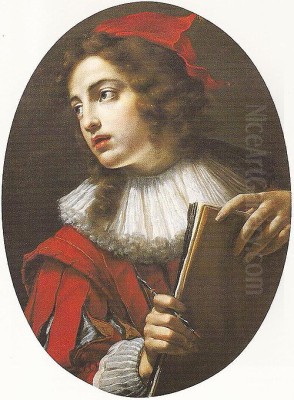
The Florence of the early seventeenth century, the city where Cesare Dandini came of age as an artist, was a place of complex cultural currents. The towering achievements of the High Renaissance were a revered memory, yet the city's artistic pulse continued to beat strongly, albeit differently. While Rome experienced the dramatic intensity of Caravaggio and the High Baroque exuberance of Gian Lorenzo Bernini and Pietro da Cortona, Florence largely cultivated a more restrained, elegant, and intellectually inclined interpretation of the Baroque style. Patronage, though still significantly influenced by the Medici Grand Dukes, was also diversifying, with noble families and private collectors playing an increasingly important role. It was within this environment, marked by a deep respect for tradition (especially the Florentine emphasis on disegno, or drawing and design) yet open to new stylistic currents, that Cesare Dandini forged his distinct artistic identity. He emerged as a leading figure, celebrated for his technical refinement, sophisticated compositions, and particularly his idealized yet psychologically nuanced depictions of female figures, often drawn from religious or allegorical sources.
Early Life and Artistic Formation
Cesare Dandini was born in Florence on October 1, 1596, into a family that would become a veritable artistic dynasty. Art was likely a part of his environment from a young age, fostering an early inclination towards painting. His formal training began under Francesco Curradi, a respected Florentine painter known for his precise drawing, somewhat conservative style rooted in late Mannerism, and devotional intensity. This initial apprenticeship would have instilled in Dandini a strong foundation in the fundamentals of Florentine draftsmanship and composition.
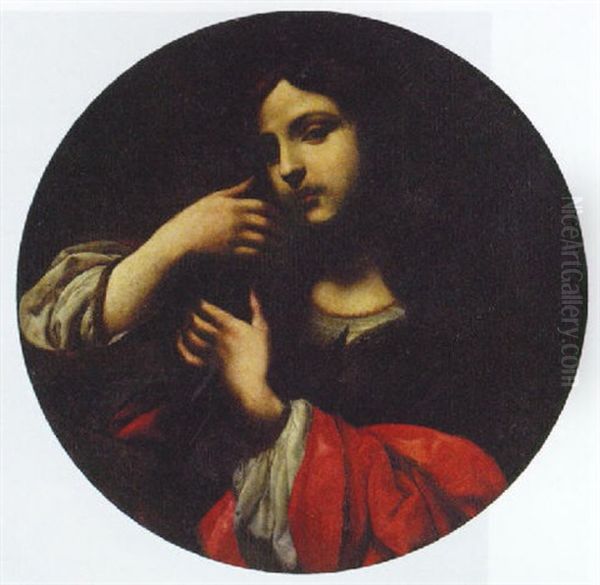
Seeking broader exposure, the young Dandini moved to the workshop of Cristofano Allori. Allori, himself the son of the prominent painter Alessandro Allori (a pupil of Bronzino), was one of the brightest stars of early Seicento Florence. His work was characterized by rich, jewel-like colours, sensuous textures, and a refined elegance that looked back to the sophisticated court style of Bronzino while incorporating a new emotional depth and subtle realism. The influence of Allori on Dandini was profound and lasting, evident in Cesare's own penchant for luxurious fabrics, smooth, porcelain-like rendering of flesh, and elegant, often melancholic, female figures.
Dandini's education was further enriched by a period with Domenico Passignano (Domenico Cresti). Passignano, having spent time in Venice, brought a different sensibility to Florence, one marked by looser brushwork, warmer colours, and a greater sense of dynamism, reflecting the influence of Venetian masters like Titian and Tintoretto. While Dandini's mature style retained a core Florentine linearity and polish, the exposure to Passignano likely encouraged a greater richness in his palette and perhaps a slightly more fluid approach to composition than might have been absorbed from Curradi or Allori alone. This combination of rigorous Florentine training and exposure to diverse influences equipped Dandini with a versatile technical and stylistic toolkit.
The Emergence of a Distinct Style
By the 1620s, Cesare Dandini began to establish himself as an independent master. An early significant work is the Pietà (Lamentation over the Dead Christ), painted around 1625 for the Sant'Anna sul Prato church in Florence (now possibly in the Ospedale di San Giovanni di Dio). This work, while showing the clear influence of his teachers, particularly in its careful composition and emotional restraint, already hints at Dandini's developing personal style. The figures are rendered with clarity and precision, and there is a palpable sense of pathos, handled with characteristic Florentine decorum.
Throughout the 1620s and 1630s, Dandini refined his signature style. Key characteristics emerged: an exquisite attention to detail, particularly in the rendering of fabrics like silk, velvet, and brocade, often depicted with intricate patterns and shimmering highlights. His figures, especially female saints and allegorical personifications, possess an idealized beauty, characterized by oval faces, large, expressive eyes, and graceful postures. Yet, this idealization is often tempered by a subtle psychological depth, a hint of introspection or gentle melancholy that prevents them from becoming mere decorative objects.
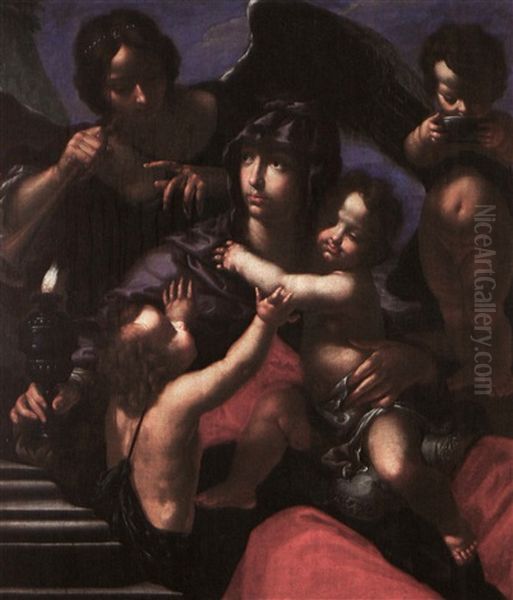
His colour palette became distinctive, often employing luminous, clear hues – rich blues, deep reds, vibrant yellows, and cool greens – set against darker, atmospheric backgrounds. While capable of depicting drama, his work generally favours harmony and balance over overt dynamism. The influence of Cristofano Allori remained evident in the elegance and refinement, but Dandini developed his own specific type, often favouring half-length or three-quarter-length figures that allowed for a focus on expression and rich costume details. His meticulous technique and the high finish of his paintings made them particularly appealing to collectors.
Religious Themes and Devotional Works
Religious subjects formed a significant part of Cesare Dandini's oeuvre, reflecting the demands of church commissions and the devotional needs of private patrons in Counter-Reformation Florence. He approached these themes with a characteristic blend of piety and aesthetic refinement. His depictions of the Madonna and Child, a perennial favourite, often emphasize the tender relationship between mother and son, rendered with graceful lines and serene expressions. Examples can be found in various collections, showcasing his ability to infuse traditional iconography with personal sensitivity.
Saints were another frequent subject. Dandini excelled at portraying female saints, often depicted as beautiful young women adorned in rich attire, blurring the lines between the sacred and the worldly in a manner typical of Florentine Baroque elegance. His Saint Catherine of Alexandria, a subject he painted multiple times, often shows the philosopher-saint with her attribute, the spiked wheel, but her regal bearing and sumptuous clothing are equally prominent. Similarly, his depictions of Saint Dorothy of Cappadocia or Saint Cecilia, the patron saint of music, allowed him to combine religious devotion with an appreciation for beauty and elaborate detail.
One of his most significant rediscovered religious works is the Holy Family with the Infant St. John. Long thought lost, a version identified as Dandini's original was found at Iona College in New Rochelle, New York, in 2022. This painting exemplifies his mature style, showcasing the intimate grouping of figures, the sweet expressions, the careful rendering of drapery, and the harmonious colour scheme. The rediscovery highlights the ongoing process of reassessing Dandini's contribution and the potential for more of his works, perhaps currently misattributed or unidentified, to emerge. His religious paintings provided believers with images for contemplation that were both spiritually resonant and aesthetically pleasing.
Allegory and Mythology: The Power of Personification
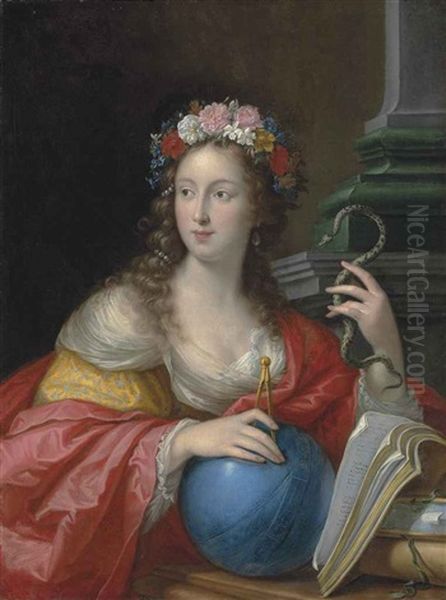
Alongside religious themes, Cesare Dandini demonstrated a remarkable talent for allegorical and mythological subjects. These works often took the form of single, idealized female figures representing abstract concepts or classical deities and heroines. This genre provided ample opportunity for Dandini to display his skill in rendering beautiful forms, luxurious textures, and conveying complex ideas through visual symbolism. These paintings were particularly popular with sophisticated private patrons who appreciated their intellectual content and decorative qualities.
A prime example is the Allegory of Charity, now housed in the Metropolitan Museum of Art, New York. This painting depicts a beautiful woman nursing one infant while another sleeps at her side, a traditional representation of Caritas. Dandini imbues the scene with warmth and tenderness, using soft lighting and a rich, harmonious palette. The figure's serene expression and the exquisite rendering of her blue robe and the infants' flesh demonstrate his mastery. This work stands comfortably alongside those of other Florentine masters like Francesco Furini, who also explored sensuous allegorical themes, though often with a softer, more sfumato technique.
Other allegorical works attributed to Dandini include personifications of virtues like Faith, Hope, or Prudence, and concepts like Music, Painting, or Intelligence (such as his Allegory of Intelligence in the Uffizi Gallery). Mythological figures also appeared, sometimes in collaboration with his brother Vincenzo. For instance, they reportedly painted pendants of Artemisia (representing conjugal fidelity) and a Bacchante (representing perhaps a contrasting abandon) for the Marquis Bartolomeo Corsini. Dandini's Helen of Troy, mentioned in sources, suggests his engagement with classical narratives known for their dramatic potential and focus on iconic female figures. These allegorical and mythological paintings cemented Dandini's reputation for elegance, intellectual depth, and visual appeal.
The Dandini Workshop: A Family Affair
Cesare Dandini was not an isolated artist but the head of a thriving workshop and the most prominent member of an artistic family. Family workshops were crucial to artistic production in Renaissance and Baroque Italy, allowing for collaboration, training, and the efficient execution of commissions. Cesare's younger brother, Vincenzo Dandini (1609-1675), was also a talented painter who trained with Cesare and often worked in a closely related style. While Vincenzo developed his own career, receiving independent commissions, collaboration between the brothers seems to have occurred, particularly on larger projects or pairs of paintings, like the aforementioned Artemisia and Bacchante for the Corsini family. Distinguishing their individual hands can sometimes be challenging, especially in works produced during their close association.
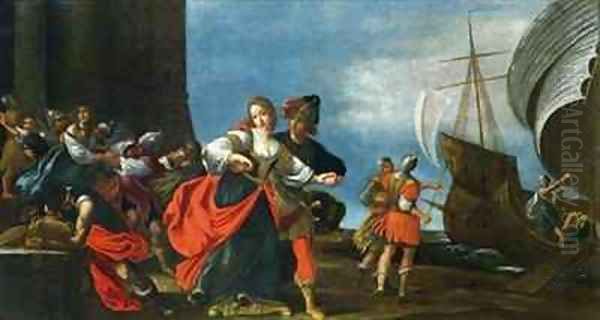
The artistic lineage continued with Cesare's nephew (Vincenzo's son), Pietro Dandini (1646-1712). Pietro, who likely received initial training within the family workshop, went on to develop a more dynamic and decorative style, influenced by later Baroque trends and artists like Pietro da Cortona and Luca Giordano. He became a prolific painter, known for his large-scale frescoes and altarpieces, carrying the Dandini name into the later seventeenth and early eighteenth centuries.
Cesare's workshop also served as a training ground for other artists. His most notable pupil was arguably Alessandro Rosi (1627-1697). Rosi absorbed Dandini's emphasis on careful drawing, rich colour, and the detailed rendering of textures, particularly complex drapery. Sadly, Rosi's life was cut short by a tragic accident, but his surviving works show the clear imprint of his master's style, albeit often with a slightly more robust or eccentric quality. The Dandini workshop, under Cesare's guidance, was thus a significant hub of artistic activity in mid-Seicento Florence, disseminating a particular brand of refined Baroque painting.
Patronage: Medici, Nobles, and Collectors
The success of an artist like Cesare Dandini depended significantly on patronage. While the grand ducal Medici court remained a central force in Florentine artistic life, Dandini seems to have particularly thrived through commissions from other noble families and private collectors. His refined style, the manageable scale of many of his works (especially the cabinet pictures), and the appealing subject matter – elegant saints, sophisticated allegories – were perfectly suited to the tastes of the Florentine aristocracy and intelligentsia.
Don Lorenzo de' Medici, the younger brother of Grand Duke Cosimo II, is known to have been a significant patron of the arts and is specifically mentioned as supporting Dandini. This connection to a member of the ruling family would have undoubtedly enhanced the artist's prestige and opened doors to further commissions. The Medici collections historically contained works by Dandini, reflecting this patronage.
The Corsini family was another major patron. Marquis Bartolomeo Corsini commissioned the collaborative pendants of Artemisia and Bacchante from Cesare and Vincenzo. The family's Palazzo Corsini al Parione in Florence also featured decorative works involving the Dandini family, indicating a sustained relationship. Such commissions from prominent families were crucial for an artist's financial stability and reputation.
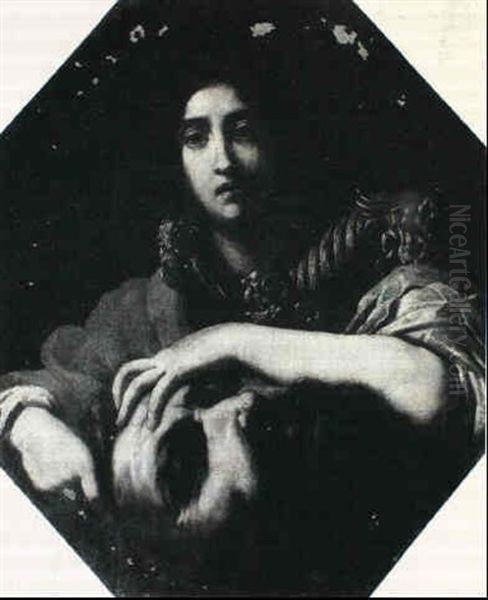
Beyond these major names, Dandini's work appealed to a broader circle of private collectors who desired easel paintings for their homes. His small-scale cabinet pictures, often featuring single figures rendered with exquisite detail and finish, were highly sought after. The portrait of the musician Bartolomeo Landini depicted as Saint John the Baptist suggests commissions from individuals outside the highest nobility, perhaps connected through cultural or artistic circles. This diverse patronage base allowed Dandini to focus on the genres and style where he excelled.
Contemporaries: Collaboration, Competition, and Context
Cesare Dandini operated within a vibrant, if somewhat conservative, Florentine art scene. His career unfolded alongside several other notable painters, creating a context of shared influences, stylistic dialogues, and inevitable competition. Understanding his relationship with these contemporaries helps to define his unique position.
His style is often compared and contrasted with that of Carlo Dolci (1616-1686). Dolci shared Dandini's meticulous technique and preference for highly finished surfaces and devotional subjects. However, Dolci's work typically possesses a more intense, almost saccharine piety and a smoother, enamel-like finish, lacking the subtle psychological complexity sometimes found in Dandini's figures. Both catered to a similar market demanding refined religious imagery.
Francesco Furini (c. 1603-1646) was another key contemporary, known for his soft, sfumato technique and sensuous, often ambiguous, depictions of female nudes drawn from biblical or mythological sources. While both Dandini and Furini excelled at rendering the female form, Dandini's approach was generally more linear and less overtly sensual, maintaining a greater sense of classical decorum even in allegorical subjects.
Other significant Florentine painters of the period included Lorenzo Lippi (1606-1665), known for his adherence to naturalism and clear, almost stark compositions, offering a stylistic counterpoint to Dandini's elegance. Jacopo Vignali (1592-1664) worked in a style that blended Florentine tradition with influences from artists like Guercino. Baldassare Franceschini, known as Il Volterrano (1611-1690), was a major figure, particularly renowned for his large-scale frescoes, representing perhaps a more dynamic and expansive Baroque vision compared to Dandini's focus on easel painting. Felice Ficherelli, called 'il Riposo' (1605-c. 1660), worked in a refined style sometimes close to Dandini's.
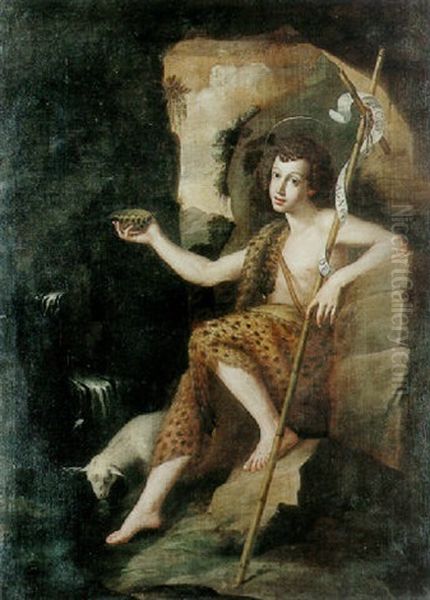
While primarily based in Florence, Dandini was not immune to broader Italian trends. The influence of the Bolognese classicist Guido Reni is often cited, particularly in the idealized facial types and graceful poses found in some of Dandini's works. Later in his career, some scholars detect an awareness of the Roman High Baroque, possibly absorbing elements of Pietro da Cortona's richer compositions and more dynamic energy, although Dandini always adapted these influences to his fundamentally Florentine sensibility. He also competed indirectly with artists favoured by different patrons, such as Gaspare Lopez or Antonio Domenico Gabbiani, who represented other facets of the diverse Baroque landscape.
Later Career and Stylistic Evolution
In the later decades of his career, from the 1640s until his death in 1657, Cesare Dandini continued to be a productive and respected artist. While his core style remained consistent, some subtle shifts and developments can be observed. There is evidence, as mentioned, of an increasing awareness of developments in Rome, particularly the work of Pietro da Cortona, who had spent time working for the Medici in Florence at the Pitti Palace. This might be reflected in slightly more complex compositions or a greater richness in certain works, although Dandini never fully embraced the High Baroque's dynamism.
His later works, such as the Saint Cecilia or the Saint Catherine, sometimes exhibit what has been described as a "dreamlike or poetic style." This might refer to a heightened sense of idealization, an even greater emphasis on decorative richness, and perhaps a more introspective or otherworldly mood in his figures. The colours remain vibrant, and the attention to detail undiminished, but the overall effect can feel more consciously artificial and exquisitely crafted, moving further from naturalism towards pure aesthetic refinement.
He continued to produce works for both public and private settings. His reputation ensured a steady stream of commissions, and his workshop remained active, training the next generation. Despite the challenges of the period, which included outbreaks of plague and shifting political dynamics, Dandini maintained his position as one of Florence's leading painters, admired for his technical brilliance and the unique elegance of his vision. His death on February 7, 1657, marked the end of a significant chapter in Florentine Baroque art.
Legacy and Rediscovery
Cesare Dandini left a significant legacy, both through his own impressive body of work and through the continuation of the Dandini artistic dynasty via his brother Vincenzo and nephew Pietro. He epitomized a particular strand of Florentine Baroque – one characterized by elegance, refinement, technical polish, and intellectual sophistication. His work provided a distinct alternative to the more dramatic and emotionally charged Baroque styles prevalent in Rome and Naples. His mastery in depicting luxurious textiles, idealized female beauty, and subtle emotional states secured his reputation among contemporaries and patrons.
For a considerable period after his death, like many artists of the Seicento, Dandini's fame somewhat diminished, overshadowed by the giants of the High Renaissance and the more famous exponents of the High Baroque. However, scholarly interest in the Italian Baroque, particularly regional schools, has revived considerably in the twentieth and twenty-first centuries. Art historians have worked to reconstruct his oeuvre, distinguish his hand from those of his brother and workshop assistants, and reassess his contribution to Florentine painting.
His works are now found in major international museums, including the Metropolitan Museum of Art in New York, the State Hermitage Museum in St. Petersburg, the Uffizi Gallery and Pitti Palace in Florence, and numerous other public and private collections across Europe and North America. The rediscovery of paintings like the Holy Family with the Infant St. John at Iona College demonstrates that our understanding of his output is still evolving. Exhibitions and publications dedicated to Florentine Seicento art have increasingly recognized Dandini's pivotal role. He is now firmly acknowledged as a master of Florentine elegance, whose paintings continue to captivate viewers with their beauty, craftsmanship, and quiet intensity.
Conclusion: Master of Florentine Refinement
Cesare Dandini stands as a quintessential representative of the Florentine Baroque. In an era marked by dramatic artistic shifts across Italy, he carved out a distinct and influential path, synthesizing the city's deep-rooted tradition of disegno and elegance with the new sensibilities of the seventeenth century. Trained by key figures like Curradi, Allori, and Passignano, he developed a signature style characterized by meticulous technique, luminous colour, sophisticated compositions, and idealized yet expressive figures.
Whether depicting serene Madonnas, elegant female saints, or complex allegorical personifications, Dandini imbued his subjects with a unique blend of grace, intellectual depth, and aesthetic refinement. His popularity with patrons, from the Medici and Corsini families to private collectors, attests to the appeal of his vision. As the head of an important family workshop, he influenced his brother Vincenzo, his nephew Pietro, and pupils like Alessandro Rosi, ensuring the continuation of his artistic lineage. While perhaps less tumultuous than some of his Roman contemporaries, Cesare Dandini's contribution to Italian art is undeniable. He remains a master of Florentine refinement, whose beautifully crafted paintings offer a compelling window into the sophisticated artistic culture of seventeenth-century Florence.